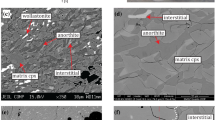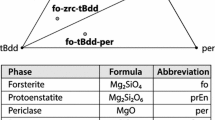Summary
Isothermal solid state experiments on the diffusion of Cu, Fe, Zn and In and related effects have been carried out in sphalerite single crystals. The driving force for the diffusion and corresponding reactions are chemical potential gradients which are established by differences in sulfur fugacity, oxygen fugacity and the chemical activity between sulfide powders as metal sources and receptor crystals.
Studies in the system ZnS-CuInS2 show replacement rims in sphalerite produced by the formation of solid solutions between ZnS and CuInS2. These differences reflect the extent of mutual solid solution. The composition profiles of these rims at different temperatures and sulfur fugacities are calculated to diffusion coefficients for the coupled substitution of Cu+ + In3+ versus 2 Zn2+. The interdiffusion coefficients of (Cu + In) in Fe-free sphalerite at the Fe/FeS sulfur fugacity of the sources obey to the relation:
D [cm2/s] = 1 * 10−3 * exp(5.53 * N) * exp((E + 2 * N)/RT) (E = -168.6 [kJ/mole]; N = mole fraction of Cu0.5In0.5S in ZnS). The interdiffusion coefficients increase with the sulfur fugacity, the Fe-content of sphalerite and in the presence of water. If Fe-bearing sphalerite crystals are used, the diffusion experiments in the ZnS-CuInS2 system at higher fS2 additionally show “chalcopyrite disease”.
Using different Cu- or (Cu + Fe)-bearing sources like CUS, Cu2S, CuFeS2, Cu5 FeS4 Fe-free sphalerite and Fe-bearing sphalerites at all fS2 show replacement rims. Fe-bearing sphalerites reveal “disease” phenomena in addition to diffusion rims and replacements depending on fS2 at corresponding metal ratios in the source. Based on the experimental studies we propose the expression “diffusion induced segregations (DIS)” instead of “disease”. The mineral phases and the texture of the DIS depend on sulfur fugacity, Cu contents of the source, annealing times and temperature. The grain sizes, forms and orientation of the DIS bodies depend on the annealing temperatures and times and the defects of the sphalerite single crystals. The DIS phases chalcopyrite and bornite are formed by reaction of the diffusing Cu with the Fe contained in sphalerite which is oxidized from 2+ to 3+ within the chemical potential gradient. If the critical Fe-content of 2–3 at % is exceeded and a minimum fS2 is reached, additionally to the occurrence of DIS, Fe decreases in the primary sphalerites. If the critical Fe-content is not reached Fe can be introduced into the sphalerite. These different phenomena can be directly correlated to natural occurrences. Following our experimental studies and descriptions of natural parageneses the “chalcopyrite disease” has to be extended to corresponding phenomena of bornite and digenite.
Zusammenfassung
In Zinkblenden wurden Experimente zur Festkörperdiffusion von Cu bzw. (Cu + In) als Diffuser aus verschiedenen sulfidischen Metallquellen durchgeführt. Die die Diffusion treibende Kraft ist ein chemischer Potentialgradient, der sich durch Unterschiede der Schwefel- und Sauerstoffugazitäten sowie der Aktivitäten zwischen den Einkristallen und den Metallquellen ergibt, wobei ein Gleichgewicht zwischen der Metallquelle und einem äußeren Schwefelpuffer eingestellt wird.
Im System Zinkblende (ZnS) als Rezeptor und Roquesit (CuInS2) als Metallquelle ergeben sich durch Mischkristallbildungen Verdrängungssäume, deren Konzentrations-profile zu Diffusionskoeffizienten der gekoppelten Substitution mit Ladungsausgleich von Cu+ + In3+ gegen 2 Zn2+ in Zinkblende berechnet wurden. Die Temperatur und Molenbruch abhängigen Diffusionskoeffizienten (D) von (Cu + In) in Fe-freier Zink-blende bei einer Schwefelfugazität der Metallquelle entsprechend dem Fe/FeS-Puffer gehorchen der Formel:
D [cm2/s] = 1 * 10−3 * exp(5.53 * N) * exp((E + 2 * N)/RT) mit E = -168.6 [kJ/mole] und N = Molenbruch von Cu0.5In0.5S in ZnS. Mit steigender Schwefelfugazität, steigendem Fe-Gehalt der Zinkblende sowie in Anwesenheit von H2O nimmt der Diffusionskoeffizient von (Cu + In) in Sphalerit zu. Werden Fe-haltige Einkristalle benutzt, so treten unter Nutzung verschiedener Cu-haltiger Metallquellen wie CuInS2, CuFeS2, Cu5FeS4, Cu2S und CuS und jeweils charakteristischen Schwefelfugazitäten massive Verdrängungen auf. Zusätzlich zu den Verdrängungen tritt “disease” in der Zinkblende auf, wenn unter trockenen Bedingungen höhere, jeweils für die Metallverhältnisse typische S-Fugazitäten herrschen und Minimalgehalte an Fe in ZnS überschritten werden. Unter wasserhaltigen Bedingungen tritt “disease” im System (Zn, Fe)S-CuInS2 bereits bei niedrigen fS2 auf. Aufgrund unserer Untersuchungen schlagen wir anstelle des bisherigen Begriffes “disease” die Bezeichnung “diffusion induced segregations” (DIS) vor. Das Auftreten verschiedener DIS Phasen wie Chalkopyrit, intermediate solid solution (iss), Bornit und Digenit sowie deren sukzessive Ausscheidung wird durch unterschiedliche Metallgehalte der Diffusionsquellen hervorgerufen. Die Korngröße,-form und Orientierung der DIS Körper hängt von der Dauer und den Temperaturen der Versuche sowie dem Realbau der Zinkblende ab. Diese Phänomene sowie ihre Texturen können mit natürlichen Erscheinungen direkt korreliert werden.
Similar content being viewed by others
References
Barton PB Jr (1973) Solid solutions in the system Cu-Fe-S, part 1. The Cu-S and Cu-Fe-S joins. Econ Geol 68: 455–465
Barton PB Jr, Bethke PM (1987) Chalcopyrite disease in sphalerite: pathology and epidemiology. Am Mineral 72: 451–467
Bente K, Doering T, Mittelstädt R (1993) Experimental studies on coupled diffusion in the system ZnS-CuInS2 and their paragenetic application. Proceedings of the Eight Quadrennial IAGOD Symposium, Ottawa 1990
Bente K, Doering T (1991) Mischkristallbildung, Phasenumwandlung und Einkristallsynthese im System ZnS-CuInS2. Chem Erde 51: 291–295
Bente K, Doering T (1993) Solid state diffusion studies in sphalerites: an experimental verification of the “chalcopyrite disease”. EJM 5 (in press)
Bortnikov NS, Genkin AD, Dobrovolskaya MG, Muravitskaya GN, Filimonova AA (1991) The nature of chalcopyrite inclusions in sphalerite: exsolution, coprecipitation, or “disease”? Econ Geol 86: 1070–1082
Brackmann AJ (1984) Self diffusion in sphalerite. Thesis, University of Toronto, 141 pp
Eldridge CS, Bourcier WL, Ohmoto H, Barnes HL (1988) Hydrothermal inoculation and incubation of the chalcopyrite disease in sphalerite. Econ Geol 83: 972–989
Goble RJ, Scott SD, Hancock RGV (1979) Diffusion rates of Zn and Fe in sphalerite. [abs]: GAC-MAC-CGU Ann Meet Quebec 4:53
Johan Z (1988) Indium and Germanium in the structure of sphalerite: an example of coupled substitution with copper. Mineral Petrol 39: 211–229
Mizuta T (1988) Interdiffusion rate of Zinc and Iron in natural sphalerite. Econ Geol 83: 1205–1220
Mizuta T, Shimazaki H, Kaneda H, Min Sung Lee (1990) Compositional variation of sphalerite from some Gold-Silver ore deposits in South Korea. J Mining College Akita Univ Series A Mining Geology 7 (3): 203–217
Nelkovski H, Bollmann H (1969) Diffusion von In and Cu in ZnS-Einkristallen. Z Naturforsch A24: 1302–1306
Ramdohr P (1975) Die Erzminerale and ihre Verwachsungen. Akademie Verlag, Berlin, 551 pp
Robie RA, Waldbaum DR (1968) Thermodynamic properties of minerals and related substances at 298.15 °K (25°C) and one atmosphere (1.013 bars) preesure and at higher temperatures. US Geol Surv Bull 1259: 256
Scott SD, Barnes HL (1971) Sphalerite geothermometry and geobarometry. Econ Geol 66: 653–669
Secco EA (1958) Diffusion and exchange of zinc in crystalline zinc sulfide. J Chem Phys 29: 406–409
Toulmin P, Barton PB (1964) A thermodynamic study of pyrite and pyrrhotite. Geochim Cosmochim Acta 28: 641–671
Wagnel C (1969) The evaluation of data obtained with diffusion couples of binary singlephase and multiphase systems. Acta Metallurgica 17: 99–107
Author information
Authors and Affiliations
Rights and permissions
About this article
Cite this article
Bente, K., Doering, T. Experimental studies on the solid state diffusion of Cu + In in ZnS and on “Disease”, DIS (Diffusion Induced Segregations), in sphalerite and their geological applications. Mineralogy and Petrology 53, 285–305 (1995). https://doi.org/10.1007/BF01160153
Accepted:
Issue Date:
DOI: https://doi.org/10.1007/BF01160153




